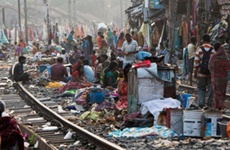India’s richest 1% corner 73% of country’s resources: survey
22 Jan 2018
The richest 1 per cent in India cornered 73 per cent of all wealth generated in the country last year, leaving only 27 per cent to the remaining 99 per cent population, in what could be the height of income inequality, a new survey shows.
 The survey by Oxfarm found that for 670 million Indians comprising mostly poor people, which is over half of the total population, their wealth rose by just 1 per cent in 2017.
The survey by Oxfarm found that for 670 million Indians comprising mostly poor people, which is over half of the total population, their wealth rose by just 1 per cent in 2017.
Last year's survey had showed that India's richest 1 per cent held a huge 58 per cent of the country's total wealth - higher than the global figure of about 50 per cent.
This year's survey also showed that the wealth of India's richest 1 per cent increased by over Rs20,90,000 crore during 2017 - an amount equivalent to total budget of the central government in 2017-18, Oxfam India said.
The survey by the international rights group was released hours before the start of the annual summit of the World Economic Forum – a congregation of the rich and powerful from across the world - in Davos, Switzerland.
The situation appears even grimmer globally, where 82 per cent of the wealth generated last year worldwide went to the 1 per cent, while 3.7 billion people that account for the poorest half of population saw no increase in their wealth.
It is four years since the World Economic Forum identified rising economic inequality as a major threat to social stability, and three years since the World Bank twinned its goal for ending poverty with the need for shared prosperity.
Since then, and despite world leaders signing up to a global goal to reduce inequality, the gap between the rich and the rest has widened. This cannot continue. As President Obama told the UN General Assembly in his departing speech in September 2016: ''A world where 1 per cent of humanity controls as much wealth as the bottom 99 per cent will never be stable.
According to Oxfam:
- Since 2015, the richest 1 per cent has owned more wealth than the rest of the planet;
- Eight men now own the same amount of wealth as the poorest half of the world;
- Over the next 20 years, 500 people will hand over $2.1 trillion to their heirs – a sum larger than the GDP of India, a country of 1.3 billion people;
- The incomes of the poorest 10 per cent of people increased by less than $3 a year between 1988 and 2011, while the incomes of the richest 1 per cent increased 182 times as much;
- A FTSE-100 CEO earns as much in a year as 10,000 people in working in garment factories in Bangladesh;
- In the US, new research by economist Thomas Piketty shows that over the last 30 years the growth in the incomes of the bottom 50 percent has been zero, whereas incomes of the top 1 per cent have grown 300 per cent; and
- In Vietnam, the country's richest man earns more in a day than the poorest person earns in 10 years.
Left unchecked, growing inequality threatens to pull our societies apart, Oxfarm pointed out, adding that it would increase crime and insecurity, and undermine the fight to end poverty; leave more people living in fear and fewer in hope
''From Brexit to the success of Donald Trump's presidential campaign, a worrying rise in racism and the widespread disillusionment with mainstream politics, there are increasing signs that more and more people in rich countries are no longer willing to tolerate the status quo. Why would they, when experience suggests that what it delivers is wage stagnation, insecure jobs and a widening gap between the haves and the have-nots? The challenge is to build a positive alternative – not one that increases divisions.''
The picture in poor countries is equally complex and no less concerning. Hundreds of millions of people have been lifted out of poverty in recent decades, an achievement of which the world should be proud. Yet one in nine people still go to bed hungry.11 Had growth been pro-poor between 1990 and 2010, 700 million more people, most of them women, would not be living in poverty today.
Research finds that three-quarters of extreme poverty could in fact be eliminated now using existing resources, by increasing taxation and cutting down on military and other regressive spending.
The World Bank is clear that without redoubling their efforts to tackle inequality, world leaders will miss their goal of ending extreme poverty by 2030.







.webp)














